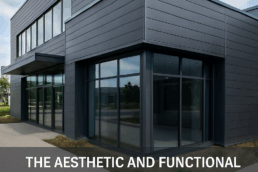Honeycomb structures have revolutionized modern architecture with their unique combination of strength, lightweight properties, and versatility. Architects and engineers have long sought materials and designs that provide high performance while maintaining efficiency.
The honeycomb structure presents itself with an elegant solution. Honeycomb structures demonstrate how biomimicry—the practice of drawing inspiration from nature—can lead to innovative solutions in various fields. From aerospace to construction and furniture design, honeycomb structures have proven their worth by offering strength, flexibility, and energy efficiency. This blog goes in-depth into the myriad benefits and applications of honeycomb structures. We uncover why they are considered the architect’s secret weapon for versatile structures.
What is a Honeycomb Structure?
A honeycomb structure mimics the natural design of a honeycomb, consisting of hexagonal cells. This geometric configuration is renowned for its efficiency and provides high strength and rigidity while remaining lightweight. The structure is a marvel of nature and a prime example of how biomimicry can influence modern engineering and architecture.
The Science Behind Honeycomb Structures
The hexagonal pattern of a honeycomb is incredibly efficient. Each hexagon shares its sides with six others, minimizing the amount of material needed to create a solid structure. This design results in a material that is both strong and lightweight. It offers an ideal solution for various architectural and engineering applications. The rigidity provided by the interconnected cells distributes weight evenly and absorbs impacts. This structure makes it highly resilient.
Historical Context and Development
The use of honeycomb structures is not entirely new. The concept has been around for centuries, with early applications in beekeeping and ancient engineering. However, it wasn’t until the mid-20th century that honeycomb structures began to be used in aerospace engineering, thanks to advancements in material science and manufacturing techniques. Today, they are a staple in various industries, each benefiting from the distinct properties of the honeycomb design.
Advantages of Honeycomb Structures
Strength-to-Weight Ratio
One of the most significant advantages of honeycomb structures is their exceptional strength-to-weight ratio. This characteristic makes honeycomb panels an excellent choice for applications where weight is a critical factor. For instance, in aerospace and automotive industries, reducing weight without compromising strength can lead to substantial improvements in fuel efficiency and performance.
Detailed Analysis of Strength
The strength of a honeycomb structure comes from its geometry. The hexagonal cells provide multiple load paths and distribute force evenly across the structure. This distribution reduces the likelihood of failure under stress, making honeycomb structures particularly resilient. Additionally, the use of advanced materials like aluminum, carbon fiber, and high-strength alloys further enhances their strength.
Weight Reduction Benefits
The lightweight nature of honeycomb structures translates to numerous benefits. For example, in aerospace, lighter components lead to reduced fuel consumption, lower emissions, and improved payload capacity. In the automotive industry, lighter vehicles offer better fuel efficiency and handling. The construction industry benefits from easier transportation and installation of building materials which lowers overall project costs.
Flexibility
Honeycomb structures can be adapted into various shapes and sizes. They offer tremendous flexibility in design. This adaptability makes them suitable for a wide range of architectural applications, from detailed interior designs to expansive structural elements. The ability to mold honeycomb panels into different forms allows architects to explore innovative and creative design solutions that would be challenging with traditional materials.
Customization and Design Freedom
The modular nature of honeycomb structures allows for easy customization. Architects can design panels that fit specific dimensions and shapes to enable complex architectural forms. This flexibility also extends to the choice of materials, finishes, and surface treatments for a wide range of aesthetic and functional possibilities.
Case Studies in Flexibility
Numerous projects worldwide showcase the flexibility of honeycomb structures. From the striking facades of modern skyscrapers to the sleek interiors of luxury vehicles, honeycomb panels are used to create visually stunning and structurally sound designs. These case studies demonstrate the potential for innovation and creativity when using honeycomb structures in architectural projects.
Energy Efficiency
The insulating properties of honeycomb structures contribute significantly to energy efficiency. The hexagonal cells trap air to provide excellent thermal insulation. This characteristic makes honeycomb panels ideal for use in building envelopes and reduces the need for additional insulation materials. This can lead to more energy-efficient buildings.
In climates with extreme temperatures, honeycomb structures can help maintain a stable internal environment to enhance the comfort of occupants. Additionally, the reduction in energy consumption directly translates to lower utility bills and better long-term financial savings for building owners. Furthermore, the environmental impact is minimized as less energy is required for heating and cooling to support sustainable building practices.
Thermal Insulation Properties
The hexagonal cells of honeycomb structures create numerous air pockets, which act as insulators. This design minimizes heat transfer, keeping interiors warm in winter and cool in summer. As a result, buildings with honeycomb panels require less energy for heating and cooling, leading to lower utility bills and reduced environmental impact.
Acoustic Insulation
In addition to thermal insulation, honeycomb structures also provide excellent acoustic insulation. The cells absorb and dissipate sound waves, reducing noise transmission between spaces. This property makes honeycomb panels ideal for use in office buildings, concert halls, and residential complexes where sound control is essential.
Applications of Honeycomb Structures
Aerospace
Honeycomb structures are extensively used in the aerospace industry due to their lightweight and strong properties. Aircraft components such as wings, fuselages, and interior partitions often incorporate honeycomb panels to reduce weight while maintaining structural integrity.
This reduction in weight leads to better fuel efficiency and overall performance. Additionally, the durability of honeycomb structures ensures they can withstand the rigorous conditions experienced during flight.
Aerospace Innovations
The aerospace industry continues to innovate with honeycomb structures. Advanced materials like carbon fiber-reinforced polymers (CFRP) and aluminum honeycomb panels are used to create lighter and stronger components. These innovations improve aircraft performance, reduce maintenance costs, and enhance passenger safety.
Examples of Aerospace Applications
Prominent examples of honeycomb structures in aerospace include the Boeing 787 Dreamliner and the Airbus A350. These aircraft utilize honeycomb panels extensively in their construction, contributing to their reputation for efficiency, performance, and passenger comfort.
Construction
In the construction industry, honeycomb panels are valued for their strength and versatility. They are used in various applications, including exterior cladding, roofing, and interior partitions. The lightweight nature of honeycomb panels makes them easy to handle and install. This reduces construction time and labor costs. Moreover, their strength and rigidity contribute to the overall durability and stability of buildings.
Structural and Aesthetic Benefits
Honeycomb panels offer both structural and aesthetic benefits in construction. Structurally, they provide a high strength-to-weight ratio so that buildings are safe and durable. Aesthetically, they offer a modern and sleek appearance with the ability to be customized in various colors, finishes, and textures.
Sustainable Building Practices
Honeycomb panels contribute to sustainable building practices. Their lightweight nature reduces transportation emissions, and their excellent insulation properties lead to energy-efficient buildings. Additionally, many honeycomb panels are made from recyclable materials. This further enhances their environmental credentials.
Furniture Design
Honeycomb structures have found their way into furniture design, where they are used to create lightweight yet strong furniture pieces. The use of honeycomb panels allows designers to produce innovative and stylish furniture that is easy to move and handle without compromising on strength. This application is particularly beneficial for modular furniture that requires frequent rearrangement or transport.
Innovative Furniture Concepts
Designers are leveraging honeycomb structures to create furniture that is not only functional but also visually appealing. The geometric patterns of honeycomb panels add a modern and sophisticated touch to furniture pieces and make them stand out in any setting. Examples include lightweight tables, chairs, and shelving units that combine form and function seamlessly.
Practical Benefits
Honeycomb furniture offers practical benefits such as ease of assembly and transport. The lightweight nature of the panels makes it easy to move and rearrange furniture, while their strength ensures longevity and durability. This combination is ideal for both residential and commercial spaces where flexibility and adaptability are essential.
Honeycomb structures are a versatile and efficient solution in modern architecture. They present a unique combination of strength, lightweight properties, and energy efficiency. Their applications span various industries, from aerospace to construction and furniture design, showcasing their adaptability and high performance. By incorporating honeycomb structures into their designs, architects and engineers can achieve innovative and sustainable solutions that meet the demands of contemporary construction and design.
Honeycomb structures represent a perfect blend of nature’s ingenuity and human innovation. Their potential for creating strong, lightweight, and energy-efficient designs makes them a valuable asset in the quest for sustainable and high-performance architecture. As technology and materials continue to advance, the applications of honeycomb structures are likely to expand to even more opportunities for creative and functional design solutions.
Are you ready to harness the power of honeycomb structures for your next architectural project? Contact C & J Metal Products today to learn how our custom sheet metal fabrication services can provide the strength, flexibility, and energy efficiency you need. Let us help you raise the bar in your designs with our expertise and state-of-the-art capabilities.



